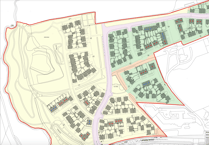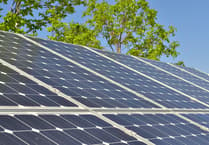PLANNING permission was denied for the installation of a solar farm at Southlands Farm, Bridgerule, but after an appeal was lodged, permission has been granted.
Lightsource Renewable Energy submitted an application for full planning permission back in July 2015 — this was then validated almost a month later on August 20.
Torridge District Council refused the application for the solar farm at Bridgerule on December 4.
Lightsource’s agents, Wardell Armstrong, then submitted an appeal against this decision and subsequently were granted planning permission on Wednesday, April 13, 2016.
The application for the installation and operation of the solar farm on land at Southland Farm was initially refused by the council as they deemed that the ‘large scale, industrial character, layout, and proximity to the other energy development (wind turbines, solar farms and pylons) would be harmful to the fabric of the landscape, including the perceptual and aesthetic qualities of this rural, agricultural landscape’.
The application for appeal was made under section 78 of the Town and Country Planning Act 1990 against the refusal to grant planning permission — they have since been successful in their appeal and Lightsource have been granted permission to continue with the erection of the solar farm.
It has been a long-standing point of contention for people living in the surrounding area as Cllr Alan Whittle, Torridge Council member for Hartland and Bradworthy (UKIP), and resident of the Bradworthy area, previously said: “It would seem that yet again an industrial sized solar farm is in the process of destroying our countryside.“
Penny Mills from CPRE Devon, who had previously objected to the proposal told the Post that this was very disappointing news, she said: “Yet more of Devon’s farmland lost and more industrialisation of the countryside.
“There are now over 4,000 acres of our green fields lost to solar in Devon alone — either already permitted or still in the planning process.
“We need farmland for food production — not power stations.”
David Hogger, an inspector appointed by the ‘Secretary of State for Communities and Local Government’ made a site visit on March 8.
In his report Mr Hogger lists the reasons for the decision, he said: “The council’s concern lies with the cumulative impact of the scheme, taking into account the number of existing (and proposed) solar farms and wind turbines in the area, which I saw on my visit.
“It states that ‘there is already a harmful cumulative effect’ on the landscape caused by the existing solar arrays, wind turbines and national grid overhead cables.
“However, although some of the existing solar arrays do have a limited visual impact when seen in isolation, I consider that they are a sufficient distance apart from each other to ensure that they do not have an over-riding influence over one’s perception of the wider countryside.”
Lightsource had previously stated that the proposed solar farm would generate locally sourced energy for around 1,500 homes, whilst saving 2,500 tonnes of carbon emissions every year — equivalent to taking 569 large family cars off the roads.
Lightsource also stated that any existing trees and hedgerow on the site would be retained and managed as part of this project, with the nearby woodland being protected through out any installation processes.
Mr Hogger states in his report under the conditions section that: “The development shall be carried out in accordance with the management proposals, habitat protection and enhancement measures contained in the Biodiversity Management Plan dated 9th October 2015.”
The land will be returned to its previous state when the site either ceases to be used as a photovoltaic park for renewable power production are at the end of the 30 years from the date of the grid connection — whichever comes first.
Lightsource now have three years from the date that permission was granted to install the solar PV array and associated infrastructure.



